Based on the first four episodes of the second season of Luke Cage, there are two primary themes of this latest baker’s dozen episodes of Marvel on Netflix: family in general and parents and children in particular, and actions of the past having consequences in the present.
This season doesn’t really waste much time getting into that, either. An issue with far too many release-the-season-at-once shows is languid pacing of the early episodes in an attempt to get people to keep watching, so revelations and actions are stretched out. Not so much, here: they’re not rushing, but they’re not taking their time, either. So far, so good, I’d say.
SPOILERS for the various Marvel Netflix shows in general and episodes 1-4 of Luke Cage season 2 in particular
In these first four episodes, Cage has embraced his status as the hero of Harlem. Everywhere he goes, people are admiring him, snapping pictures and video, taking selfies with him. There’s even an app that follows him around and lets people know where to find him. “It’s like Waze for you,” D.W. explains.
(By the way, D.W. is based on a character from the comics, specifically the manager of the Times Square movie theatre Cage had an apartment over. This was back in the days before Disney got its hands on Times Square, and the Gem Theatre was a run-down revival house that showed old Westerns. D.W. managed the place for his uncle, and he was also a film school student. Updating him to Cage’s self-appointed videographer and social media handler is perfect. Jeremiah Craft just nails the role.)
On top of that, Cage’s trip south with Claire Temple toward the end of season 1 to visit Noah Burstein seems to have had an effect, as his skin is even harder. At one point, he’s shot with a Judas bullet, and nothing happens. For one thing, this means that the only weapon that’s been known to work against him doesn’t anymore. (Mariah Dillard is, as one might imagine, unhappy about this to say the least.) For another, this, combined with the approbation from all over (magazine articles, praise on TV, radio, and the Internet, constant adulation from the citizens of Harlem), leads to a level of overconfidence we’ve never seen in Cage before. His constant reassurances in each of the first two episodes that nothing can hurt him is a textbook example of what my high-school English teachers would repeatedly refer to quite rightly as hubris.
It doesn’t take long for the fall that follows that particular brand of pride to goeth, as Bushmaster beats the living shit out of him at the top of episode four. That video of that D.W. took (thinking he was getting another Cage smackdown) goes viral, and suddenly, Cage can be hurt. Oops.
In addition to his overweening pride, though, Cage is also feeling considerable anger, which brings us to Theme #1. At the top of the season, Cage isn’t angry. He’s upset—someone is dealing heroin in bags labelled “LUKE CAGE,” with corner boys hawking it as “bulletproof.” The co-opting of his name is enough to get him to take action to try to find out who’s using his name and to get Luke Cage smack off the streets.
But the anger doesn’t happen until he discovers that there’s a new preacher in Harlem: James Lucas, Cage’s father. We find out that Reverend Lucas never visited his son in Seagate, and Lucas finds out that Cage now knows his secret: that Willis “Diamondback” Stryker was Cage’s illegitimate half-brother.
It is really too bad that we won’t be seeing the Reverend Lucas after this—that isn’t a spoiler, but this was Reg E. Cathey’s last role before he died, and while it’s possible that Lucas will live and they’ll re-cast, I don’t see how they can, as Cathey’s presence and voice are both so unique.
After that meeting on the street, though—and Lucas’s second attempt to visit Cage at Pop’s—Cage’s rage is simmering. Claire Temple sees this and tries to get him to reconcile with his father. Cage refuses, which brings us to Theme #2: Lucas didn’t acknowledge Stryker, which is a big reason why Stryker framed Cage, which is how Cage wound up in Seagate to be experimented on, which is what led to Reva and Kilgrave killing her and everything else. That one act by Lucas had massive consequences, the worst of which was the death of someone Cage loved. Cage isn’t ready to forgive that.
And he isn’t ready to let go of his anger over it, either, as we see at the end of episode 2. Cage and Temple have learned that Dillard is looking for a buyer for her massive gun cache. (What they don’t realize—not that they’d care if they did—is that this is one final sale before she gets out of the gun business. She wants to go legit and further her political career.) She has three possible buyers, and one of them is a gangster nicknamed Cockroach. In addition to shooting Cage with a multi-barrel shotgun that blows him out a window, dislocating his shoulder, Cockroach also beats up his girlfriend and son. Alerted by a concerned neighbor, Cage arrives at Cockroach’s place and just wails on him. He doesn’t tap him on the head to knock him out, he furiously tosses him around the apartment. This is the same Luke Cage who in The Defenders would only go with a plan that involved no killing, and he comes within a hairsbreadth of killing Cockroach. I hasten to point out that this isn’t bad or inconsistent writing—this is who Cage is becoming thanks to the anger at seeing his father.
Temple and Detective Misty Knight cover for him, but he’s still pissed at Temple getting in his business (which is ridiculous, as she’s his partner in more ways than one), and he finally explodes, punching a hole in Temple’s wall.
That’s the last straw for her, because she grew up in that apartment watching her father punch walls—and other things. She’s seen rage turned to violence, and she won’t live with that. By episode four, she’s moved out, and Cage is homeless (recall that his last apartment was blown up). In that same episode, another parent-child relationship removes Cage’s other support, the steady Bobby Fish, who has been acting as Cage’s agent and sounding board. Fish’s estranged daughter in California has reached out to him for a kidney transplant, and so he has to fly out there to help her.
One thing this season of Luke Cage is doing that the last two Marvel Netflix seasons (Punisher season one and Jessica Jones season two) didn’t do is acknowledge the other Marvel Netflix material. I discussed that aspect of Punisher in my review of that for this site, and the lack of any reference to Cage or any of the events of Defenders was a major gap in Jones season two. (I mean, there were several points in the latter when Jones should have tried to call Cage.)
Buy the Book
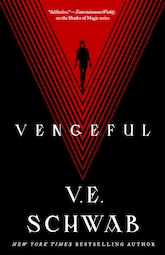

Vengeful
But the fallout of the fight against the Hand is woven throughout these first four episodes, starting with the other reason Temple is worried about Cage: she doesn’t want what happened to Matt Murdock to happen to him. (Remember that everyone believes Murdock to be dead after Defenders.) By the same token, Cage’s early hubris is as much borne of the fact that he helped defeat the Hand as it is his defeat of Diamondback in season one of his show.
The biggest consequence, of course, is Knight’s right arm, or rather lack of same. She lost her arm saving lives and being a hero, and she seems to be the only public part of Defenders‘s climax—she even got to meet the mayor! She’s put on light duty at NYPD (which wouldn’t happen, by the way—she’d immediately be medical’d out with a full pension, an option that one of the other detectives does mention), inexplicably still allowed to carry a gun (which also wouldn’t happen). Her captain threatens her repeatedly with consequences if she keeps investigating Dillard on her own and assisting Cage, but she keeps doing it, and you know that will bite her on the ass eventually.
However, Knight is trapped between a rock and a hard place. She doesn’t want pity, she wants to be treated the same as she was before she lost the arm, but she also has to acknowledge that things are different. For starters, she’s right handed. She has to re-learn how to write, how to drive (how does she change gears, anyhow?), and how to fight. Plus, in addition to her losing a limb and everything that comes with it, she’s got a cloud over her head thanks to her former partner Rafael Scarfe being exposed as dirty. (Cockroach is only out on the street because his conviction was vacated due to Scarfe’s corruption.)
She also does physical therapy work with Temple and training with Colleen Wing. After the latter, they go out for drinks and get into a bar fight, which is the single greatest scene in the history of the universe. (They released it on YouTube as a teaser for this season ahead of time. “I don’t look down before I flush.” Beautiful.) Wing insists that she can still be a badass—right after tossing her to the mat—and when a guy in the bar recognizes her as the cop who put his brother away, she gets to prove it. The fight is glorious, and Wing doesn’t get involved until she has to, letting Knight prove herself first. (Later, Wing and Danny Rand—who is mentioned but not seen, which is the best way to feature the MCU’s Iron Fist—send her the schematics of a bionic arm as developed by Rand Enterprises. This will probably be important later.)
Seriously, guys, we need a Daughters of the Dragon series right now, dagnabbit! Simone Missick and Jessica Henwick have glorious chemistry together and we need to see more of it. Like, now. Immediately.
Ahem. Anyhow, in addition to all this with Cage and Knight, we’ve got our bad guys. Dillard is trying to go legit, and to that end, her manager tracks down her estranged daughter Tilda, a medical doctor who has gotten into holistic medicine and opened a shop in Harlem. Dillard didn’t do much to raise her, but then we know from last season that she’s the product of her uncle raping her. Shades is very not happy about this, as Dillard’s renewed relationship with Tilda is cutting into their nookie time. He’s also not happy about her going legit, because that’s not really his world. But Dillard wants to sell the last set of guns and get out of it, and focus on her Family First! initiative and ignore her family’s (and her own) horrible past.
(Tilda is also the MCU version of the longtime Cage comics villain Deadly Nightshade, so one suspects a sinister arc in her future.)
And then we have Bushmaster. Four episodes in, we don’t know precisely why he took over the Jamaican gangs in Brooklyn and has such a hard-on for taking over Harlem and such a mad-on for the Stokes family. He has a pathological insistence on referring to Dillard as “Mariah Stokes,” and there’s some serious family shit going on there. It’s hinted at in Bushmaster’s talk with Dillard in episode four, but we don’t know the details yet.
Throughout all of this, the acting is superlative. Mustafa Shakir is magnificently menacing as Bushmaster—though his family moments at Gwen’s Restaurant in Brooklyn are also genuine, which helps humanize the guy who spends most of his time being a big scary monster type. (Every scene in Gwen’s shines, actually, particularly the scene where Cage goes there trying to track down the head of the Jamaican gang—who, unbeknownst to him at the time, has been killed and replaced by Bushmaster. The four old guys playing dominoes in the restaurant are a delight, and right after we do Daughters of the Dragon, I’d like the series that’s just those four guys ragging on each other and everyone who walks in the restaurant, please. Okay, maybe not, but even if these four can be the Statler and Waldorf of the Netflix MCU, I’d be okay with that.) Alfre Woodard is brilliant as always, as the sharp state of denial that Dillard is in as she drinks her way through life is palpable—but the minute she’s in public, the radiant smile is back and she’s Councilwoman Dillard again, wowing everyone with her honeyed words and grand speeches. Theo Rossi’s Wormtongue act is even stronger this season as Shades, and it’s fun seeing him teamed up with Commanche as they are in the comics (though Commanche is actually informing for the cops, as we find out in episode four). Missick is playing Knight’s PTSD and dogged determination spectacularly, and Henwick’s one appearance mostly makes us long for more. Cathey was one of our finest actors and his final performance is a bravura one, and Ron Cephas Jones is steady and superb as Fish.
And the stars hit it out of the park. Rosario Dawson has been the glue holding the Netflix series together, and the scene where she and Cage argue over his growing anger is brilliant. Some of the dialogue is a bit too on the nose, but even so, their talk plays on so many different levels, from Cage mansplaining racism to a Afro-Cubano woman to the genuine revulsion and fear on Dawson’s face as Temple says she needs to get out of there after Cage hit the wall. With every self-righteous utterance, Cage looks worse and worse, but to his credit, he figures it out by the end—but by then, it’s too late. He’s already put a hole in the wall, and Temple has to get out before the next thing he puts a hole in is her.
Cage has already fallen pretty far by the end of the fourth episode: his temper is fraying (which is dangerous for a guy who can, as Fish reminds him, throw a Volkswagen), Temple’s gone, Fish is leaving, Bushmaster has given him a concussion, and at the very end of the episode he’s served with court papers indicating that he’s being sued. A third of the way through, things are falling apart. Next week, we’ll see whether or not the center can hold with a look at episodes 5-8, with episodes 9-13 the following week.
SPOILER ALERT! Please try to keep the comments as spoiler-free of episodes 5-13 as possible.
Keith R.A. DeCandido reviewed the first seasons of Iron Fist, The Defenders, and The Punisher for this site, and over on Patreon, he reviewed season 2 of Jessica Jones and the start of season 5 of Agents of S.H.I.E.L.D. He writes “4-Color to 35-Millimeter: The Great Superhero Movie Rewatch” for this site each Friday, covering every live-action movie adaptation of a superhero comic, and has also written about Star Trek, Stargate, Batman, Wonder Woman, Doctor Who, and much more here. In addition, he’s the author of a metric buttload of fiction, including two forthcoming fantasy novels, Mermaid Precinct and A Furnace Sealed, and the recent “Marvel’s Tales of Asgard” novel trilogy starring Thor, Sif, and the Warriors Three.










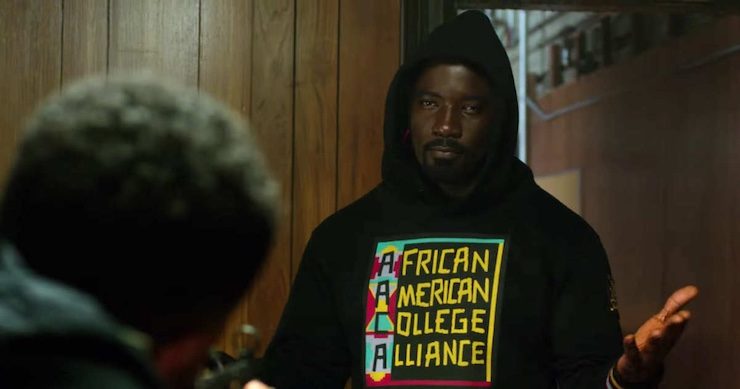
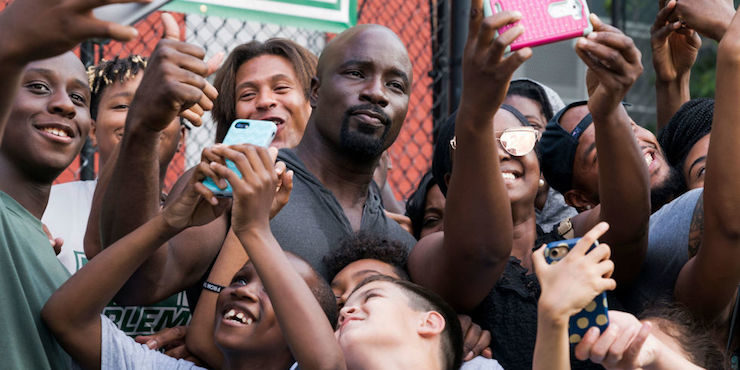
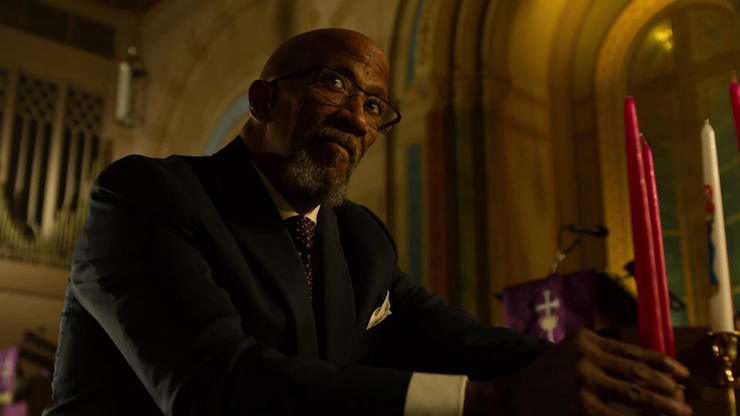
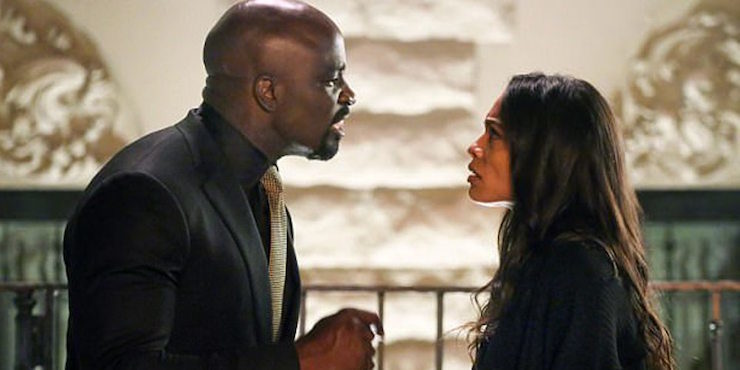
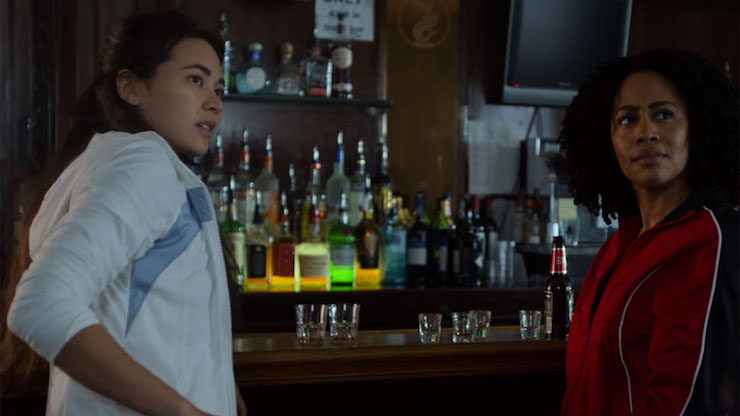

Saying that Cage is “mansplaining” racism is unfair. Their experiences with racism are different; his on the streets, hers in her home and family life. So he is just describing things from his side, which a man should be allowed to do to a woman without being hit with an inflammatory term. Or was Claire “womansplaining” to Cage in response?
I’ve been eagerly anticipating this post, thanks Keith.
As for:
//” I’d like the series that’s just those four guys ragging on each other and everyone who walks in the restaurant, please. “//
…I’m afraid you’ll be disappointed…
Was I the only one that felt a bit uncomfortable every time Luke is talking to someone about Claire and they keep referring to her as “his woman” and he replies calling her “my woman”?
Stokes. Her name is Stokes.
Hells yes to a Daughters of the Dragon series! Although they probably shouldn’t use any of the crew from this show. Someone is seriously infatuated with Miss Missick. She has a very expressive face and I like looking at it, but the camera lingers on her so much it could lead to serious pacing issues. There are some slow scenes with Misty, like minutes looking thru filing cabinets stuff.
Ironically, I advocated for such slower scenes when DD S1 came out, saying if you love the characters/performers, such scenes were OK. No need for the quick cuts that had to be built in for commercials. Now, though the pacing is better this season, I’d say cut these series by at least an episode.
One running joke I liked was about women offering Luke coffee. Even Cockroach’s old lady neighbor does it. Another running joke is Luke learning Jamaican curse words. It’s also how we know Mariah is ready to get nasty later on, when she uses a pretty bad one.
Lastly, Mustafa Shakir is ridiculously magnetic as Bushmaster. The showrunner said they wanted a Killmonger level villain and they’re not far off in the charisma department.
‘Some of the dialogue is a bit too on the nose’. No sh*t. I’ve mostly liked what I’ve seen so far this season (up to ep6) but I felt that break-up scene was so forced. Surely Clair is smart enough not to bring up going to see his father behind his back during an argument that’s already going badly.
My favourite thing so far is how insulted all the Jamaicans are (repeatedly) by the suggestion Cage might be faster than Usain Bolt…
Teokiya: yeah, that’s an amusing running gag. And I’m glad to see that they’re getting the accents and speech patterns right, even though not all the actors are Jamaican (including Shakir, who was actually born in Harlem).
—Keith R.A. DeCandido
@8 krad Bushmaster was also born in Harlem, so nice symmetry there…
Mustafa Shakir’s accent was just awesome, I’d never seen him before and presumed he was Jamaican. Just a delight to listen to him speak every word, especially the unintelligible ones. There were a couple of places I had to back up and listen again several times. The little annoyed hiss sound he’d make was an excellent little touch, no idea if that’s a common affectation in Jamaican speech, but I think it added a lot of realism to his character.
Overall, I liked the series. It wasn’t as good as the first half of S1, but was better than the second half of S1. The dialog was a little stiff in the first episode, but that seemed to smooth out after a bit.
Speaking of their accents, I always watch Marvel TV shows with subtitles on – if I have the volume low enough that the fight scenes aren’t crazy loud, I have a hard time hearing everything when they have a soft conversation.
The scenes with the Jamaican accents were funny to watch with subtitles on.
Bushmaster would say something like: “Me am in de right place, bredren, see?”
Subtitles would say: “I am in the right place, my brother, you understand?”
Some amusing moments.
Man , was I terrified for Claire for a moment when Luke punched the wall. I knew he wouldn’t hurt her, but that he could, without meaning to, really scared me. Powerful scene, and it showed the height of Luke’s hubris.
It really is sad we won’t see more of Reg E. Cathey as Reverend James Lucas; his scenes were a highlight of these episodes.
Any way to find out why a comment was removed? I think I was talking about a novel that dealt with Jamaican gangs in New York. It was well-received, even winning the prestigious Booker Prize. It’s subject matter was related to what went on in this show. And it related to actual books we saw Luke reading on the show.
The comment unpublished at 13 was responding to the spam link unpublished at 12–since the spam was removed, the response on its own no longer made sense. There wasn’t any discussion of a novel involved–maybe that’s on another thread?
Oh ok, forgot I flagged the spam. Just wanted to know if I’d crossed the line. Thanks.